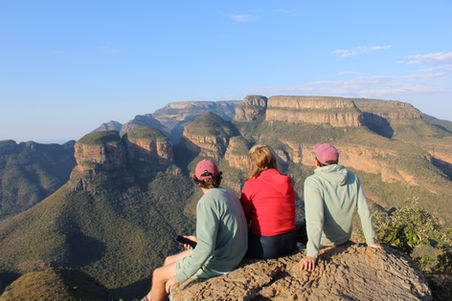South Africa - Big Five vs Non-Big Five Reserves: What’s the Difference?
- Hamba Africa
- Apr 23
- 6 min read
Ever dreamed of travelling through the African bush at sunrise, tracking elephants, or helping endangered wildlife in need? Well, grab your boots and your sense of adventure, because this is your chance to live and breathe conservation in South Africa!

So.... who travels to South Africa?
Anyone who's wild about wildlife. The reasons people come to South Africa are as diverse as the animals themselves, some come to volunteer in an effort to support conservation directly, others such as gap year travellers or even retirees join for the adventure. Hamba Africa also hosts university students and can even support them with applications for placement funding or enrolment with our UCAS/College credit awarding and internationally accredited wildlife diplomas to boost their studies. Then there's those going through a metamorphosis and thinking of a career change into something real such as the life of a safari guide.
Whatever of our placement or project you'll join, you'll gain hands-on experience, practical conservation skills, knowledge and inspiration that stays with you for life!
South Africa - Big Five vs Non-Big Five Reserves
So, you’re planning a trip to South Africa, you've likely heard about the Big Five—but, now you've come across Non-Big Five reserves and you’re wondering, “What’s the difference?”
Are the Big Five all that matters, or are the Non-Big Five reserves just as exciting?
We'll explore that below and give you some insights and tips.

What’s the Big Five?
The Big Five refers to the five most iconic and sought-after animals in Africa: the lion, leopard, elephant, rhinoceros, and buffalo. Back in the day, these were considered the toughest animals to hunt, but now they’re the stars of safari experiences and have kept this title. It is a common aspiration to sight each of the Big Five species when visiting South Africa, however there are many other fascinating species that in some instances are harder to find - each and all provide a wonderful and valuable sighting experience!
Key features of a Big Five reserve
Reserves or wildlife areas that host the Big Five often share a couple of key characteristics.
Size The Big Five as species are either large herbivores (sometimes called megafauna) or apex predators (in the case of lions or leopard). As such, when an animal occupies these niches high on the top of an ecosystem, it means the ecosystem itself needs to be large enough to support them.
You can be pretty confident that a reserve that hosts Big Five wildlife will be several thousands or tens of thousands of hectares of pristine wilderness ready to be explored!
Location
An unfortunate reality is that Big Five wildlife and urban or populated areas don't mix well, this means to get to a place with these powerful and captivating species, you'll likely have to travel far away from big cities or industry.
This also holds the promise that these areas should be picturesque and untouched areas of natural beauty.
Resilience Because a Big Five reserve has the "full suit" of large animals, each playing an important role in the ecosystem, its more typically a Big Five reserve can self regulate. From different predators ensuring prey species don't overpopulate, to large herbivores influencing the environment around them as the dig holes, topple trees or spread seeds.
This means ecologists and conservationists can have more of a hands-off management approach when protecting these areas letting nature do the work for them.

If you want a chance to see the big five up close and personal - check out our Endangered Species Wildlife Volunteer placement:
📍 Location: Waterberg, South Africa
Right in a protected Big 5 reserve—yes, that means lion, leopard, rhino, elephant, and buffalo territory. You might also get the chance to see lots of other species like eland, cheetahs, hippos, zebras and more!
📅 Stay for a While: 2 Weeks Minimum – 3 Months Max
The longer you stay, the more you learn, and the more impact you have. Start from 2 weeks and stay up to 12. Trust us, once you’re here, you’ll never want to leave.

Non-Big Five Private Reserves: The Underrated Gems

Non-Big Five reserves have their own unique charm, and they’re worth considering if you’re looking for something different and have varied interest when it comes to the value each species contributes to their surrounding ecosystem, and species-specific traits and behaviour. These reserves don’t necessarily focus on the Big Five, but they offer a safari experience that’s just as special and sometimes the opportunity for more specialist research projects.
In these areas, you can expect to see a wider variety of wildlife that doesn’t get the same level of fame but still plays a crucial role in the South African ecosystem. We're talking about serval, aardvark, giraffes, zebras, warthogs, honey badgers, and hyenas—not to mention a ton of birds, reptiles and insect. In fact, many of these reserves are absolutely perfect for birdwatching and spotting rare species.
Key features of Non-Big Five Reserves

Less Crowded: Since you’re not going for the Big Five spectacle, these places tend to be quieter, with fewer vehicles in the area. So, if you love the idea of a peaceful, more intimate experience in nature, this is a huge win.
No animal left behind: Many Non-Big Five reserves are dedicated to conservation projects for species that get out competed by the Big Five, for example: animals like cheetah or brown hyena don't do well with lions, so you might see animals that are more endangered or even participate in specialist conservation work.
Sustainable tourism: although Big Five reserves are still wildlife havens and do fantastic work, because non-Big Five reserves don’t have to meet most tourists "African dream" (see a lion or elephant!) they can avoid this social or commercial pressure and focus completely on ethical practices.
Safety: Non-Big Five reserves are simply safer areas to explore, this is especially important for university based scientific research or ecological management projects. These can be completed on foot comfortably and at leisure, you can place camera traps, search for biological samples or even take part in K-9 anti-poaching patrols on knowing you aren’t going to run into something as risky as a lion or elephant.
Why You’ll Love This Placement
Our Wildlife & Ecological Research Internship is more than just a volunteer program—this is a full-on immersion into conservation science, where you’ll be trained, mentored, and trusted to help protect endangered species and ecosystems. You just need passion, curiosity, and a love for wildlife to join, but it would benefit those studying a related course too!
Although this placement is based on a non-big Five reserve, it does have a population of white rhino, the safest and most predictable of the Big Five.
Whether you’re taking a gap year, career break, are an aspiring conservationist needing a university approved study placement or just feel called to do something meaningful with your time—this is your adventure.
📍 Location: Near the Pilanesberg NP, South Africa
Situated on a boundary of the highveld and bushveld regions with open plains, acacia woodland and seasonal streams - a classic picture of the bush!
📅 Stay for a While: 2 Weeks Minimum – 3 Months Max
Start from 2 weeks and stay up to 12. This placement suits those planning to stay a little longer to really immerse in the conservation lifestyle.
Aspiring Conservationists - Ready to Join the Wild Side?
We hope this article on South Africa - Big Five vs Non-Big Five Reserves was helpful.
If you want to learn more about which project, placement or reserve would be better suited to you and your goals, make sure to reach out to our team.
Most of our projects are available year round, and whether you want to stay for 2 weeks or 3 months, we’ll help you plan your conservation journey.
📩 Contact us today to secure your placement and start prepping for the most unforgettable experience of your life.










































Comments